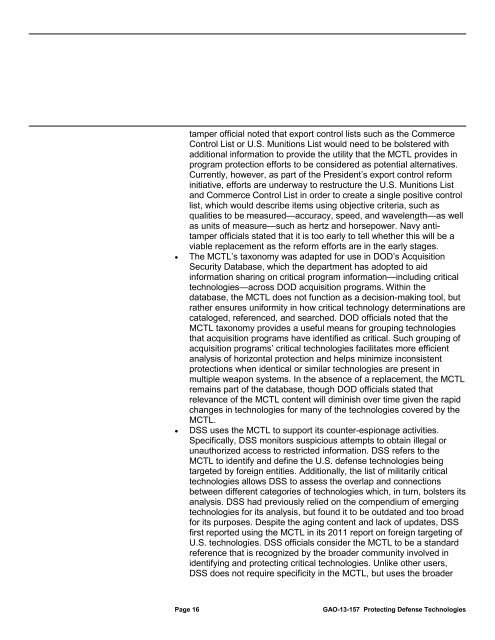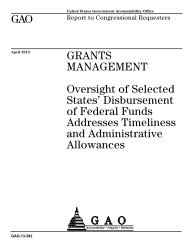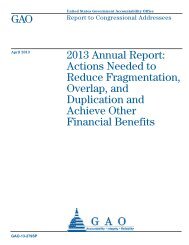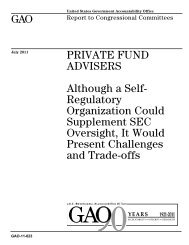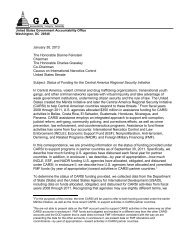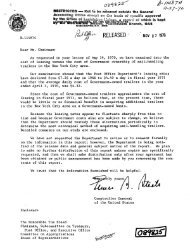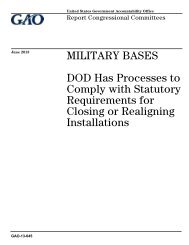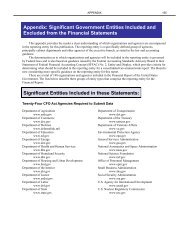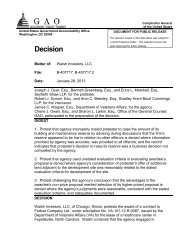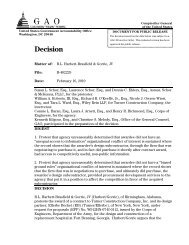GAO-13-157, PROTECTING DEFENSE TECHNOLOGIES: DOD ...
GAO-13-157, PROTECTING DEFENSE TECHNOLOGIES: DOD ...
GAO-13-157, PROTECTING DEFENSE TECHNOLOGIES: DOD ...
You also want an ePaper? Increase the reach of your titles
YUMPU automatically turns print PDFs into web optimized ePapers that Google loves.
tamper official noted that export control lists such as the Commerce<br />
Control List or U.S. Munitions List would need to be bolstered with<br />
additional information to provide the utility that the MCTL provides in<br />
program protection efforts to be considered as potential alternatives.<br />
Currently, however, as part of the President’s export control reform<br />
initiative, efforts are underway to restructure the U.S. Munitions List<br />
and Commerce Control List in order to create a single positive control<br />
list, which would describe items using objective criteria, such as<br />
qualities to be measured—accuracy, speed, and wavelength—as well<br />
as units of measure—such as hertz and horsepower. Navy antitamper<br />
officials stated that it is too early to tell whether this will be a<br />
viable replacement as the reform efforts are in the early stages.<br />
• The MCTL’s taxonomy was adapted for use in <strong>DOD</strong>’s Acquisition<br />
Security Database, which the department has adopted to aid<br />
information sharing on critical program information—including critical<br />
technologies—across <strong>DOD</strong> acquisition programs. Within the<br />
database, the MCTL does not function as a decision-making tool, but<br />
rather ensures uniformity in how critical technology determinations are<br />
cataloged, referenced, and searched. <strong>DOD</strong> officials noted that the<br />
MCTL taxonomy provides a useful means for grouping technologies<br />
that acquisition programs have identified as critical. Such grouping of<br />
acquisition programs’ critical technologies facilitates more efficient<br />
analysis of horizontal protection and helps minimize inconsistent<br />
protections when identical or similar technologies are present in<br />
multiple weapon systems. In the absence of a replacement, the MCTL<br />
remains part of the database, though <strong>DOD</strong> officials stated that<br />
relevance of the MCTL content will diminish over time given the rapid<br />
changes in technologies for many of the technologies covered by the<br />
MCTL.<br />
• DSS uses the MCTL to support its counter-espionage activities.<br />
Specifically, DSS monitors suspicious attempts to obtain illegal or<br />
unauthorized access to restricted information. DSS refers to the<br />
MCTL to identify and define the U.S. defense technologies being<br />
targeted by foreign entities. Additionally, the list of militarily critical<br />
technologies allows DSS to assess the overlap and connections<br />
between different categories of technologies which, in turn, bolsters its<br />
analysis. DSS had previously relied on the compendium of emerging<br />
technologies for its analysis, but found it to be outdated and too broad<br />
for its purposes. Despite the aging content and lack of updates, DSS<br />
first reported using the MCTL in its 2011 report on foreign targeting of<br />
U.S. technologies. DSS officials consider the MCTL to be a standard<br />
reference that is recognized by the broader community involved in<br />
identifying and protecting critical technologies. Unlike other users,<br />
DSS does not require specificity in the MCTL, but uses the broader<br />
Page 16<br />
<strong>GAO</strong>-<strong>13</strong>-<strong>157</strong> Protecting Defense Technologies


